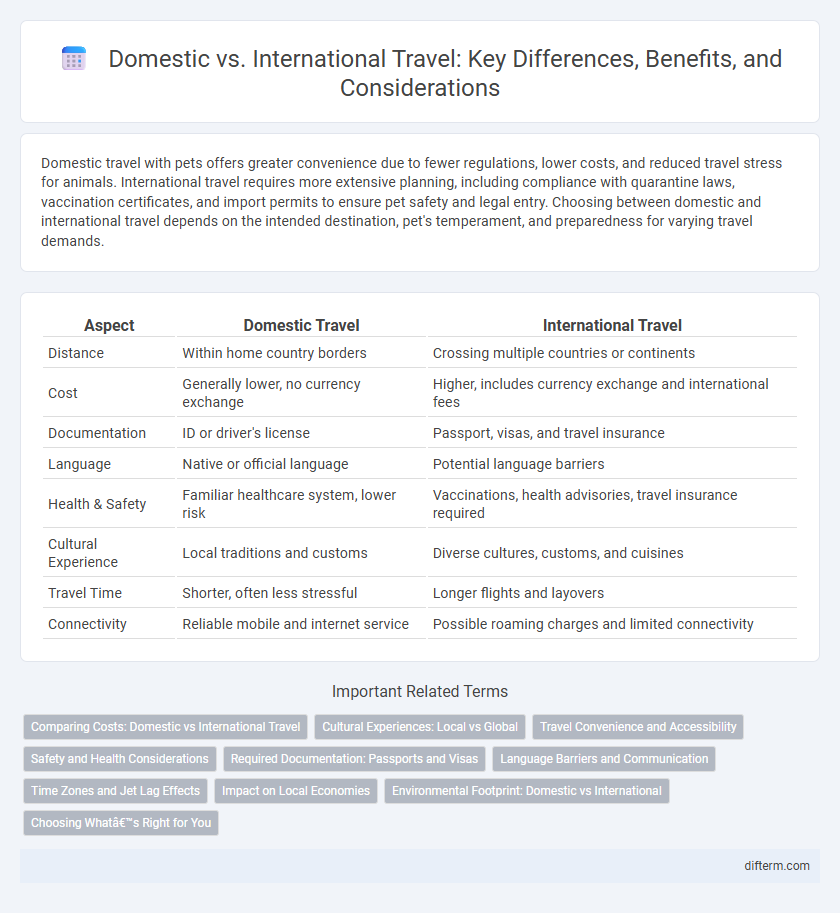Domestic travel with pets offers greater convenience due to fewer regulations, lower costs, and reduced travel stress for animals. International travel requires more extensive planning, including compliance with quarantine laws, vaccination certificates, and import permits to ensure pet safety and legal entry. Choosing between domestic and international travel depends on the intended destination, pet's temperament, and preparedness for varying travel demands.
Table of Comparison
| Aspect | Domestic Travel | International Travel |
|---|---|---|
| Distance | Within home country borders | Crossing multiple countries or continents |
| Cost | Generally lower, no currency exchange | Higher, includes currency exchange and international fees |
| Documentation | ID or driver's license | Passport, visas, and travel insurance |
| Language | Native or official language | Potential language barriers |
| Health & Safety | Familiar healthcare system, lower risk | Vaccinations, health advisories, travel insurance required |
| Cultural Experience | Local traditions and customs | Diverse cultures, customs, and cuisines |
| Travel Time | Shorter, often less stressful | Longer flights and layovers |
| Connectivity | Reliable mobile and internet service | Possible roaming charges and limited connectivity |
Comparing Costs: Domestic vs International Travel
Domestic travel typically incurs lower transportation expenses, including cheaper airfare and ground travel costs, compared to international trips that often involve higher airline fees and visa charges. Accommodation prices within a country generally remain more predictable, while international travel might require budgeting for currency exchange rates, travel insurance, and international roaming. Meal and activity costs vary less domestically, whereas international destinations can introduce diverse pricing influenced by exchange fluctuations and local economic conditions.
Cultural Experiences: Local vs Global
Domestic travel offers immersive cultural experiences rooted in familiar traditions, regional cuisines, and local festivals that provide deep insights into a country's heritage. International travel exposes travelers to diverse global cultures, languages, and customs, broadening perspectives and fostering cross-cultural understanding. Both travel types enrich cultural awareness, with domestic trips highlighting nuanced local practices and international journeys showcasing worldwide cultural diversity.
Travel Convenience and Accessibility
Domestic travel offers greater convenience through shorter transit times and fewer logistical requirements, facilitating spontaneous trips and easier access to local attractions. International travel often involves longer flights, visa arrangements, and more complex airport procedures, which can limit accessibility for some travelers. Accessibility improvements, such as increased flight options and streamlined customs processes, are gradually enhancing the international travel experience.
Safety and Health Considerations
Domestic travel generally presents fewer health risks due to familiar healthcare systems and reduced exposure to unfamiliar pathogens. International travel requires careful planning around vaccinations, travel insurance, and understanding local health infrastructure to mitigate risks associated with disease outbreaks or medical emergencies. Travelers should also monitor travel advisories and maintain hygiene protocols to ensure safety regardless of destination.
Required Documentation: Passports and Visas
Domestic travel typically requires only a government-issued photo ID, such as a driver's license, whereas international travel mandates a valid passport for entry and exit verification. Many countries also require travelers to obtain a visa in advance or upon arrival, depending on bilateral agreements and the traveler's nationality. Understanding specific visa requirements and passport validity rules is crucial to avoid travel disruptions and ensure a smooth border crossing experience.
Language Barriers and Communication
Language barriers significantly impact both domestic and international travel, influencing ease of communication and overall experience. Domestic travel typically presents fewer language challenges as travelers usually share a common language, facilitating smoother interactions with locals and service providers. In contrast, international travel often involves navigating multiple languages, requiring travelers to use translation tools, non-verbal cues, or learn basic phrases to overcome communication obstacles effectively.
Time Zones and Jet Lag Effects
Domestic travel typically involves fewer time zone changes, reducing the risk of jet lag and allowing for quicker adjustment to new schedules. International travel often crosses multiple time zones, causing disruptions to the body's circadian rhythm and resulting in fatigue, insomnia, and reduced cognitive function. Understanding time zone differences helps travelers plan rest and activities to minimize jet lag effects and enhance overall travel experience.
Impact on Local Economies
Domestic travel boosts local economies by increasing demand for regional services such as hotels, restaurants, and transportation, directly supporting small businesses and creating employment opportunities. International travel brings higher revenue through increased spending on luxury accommodations, cultural attractions, and international shopping, fostering economic diversification and infrastructure development. Both forms of travel stimulate economic growth, but domestic travel ensures reinvestment within local communities, while international tourism injects foreign currency critical for national economies.
Environmental Footprint: Domestic vs International
Domestic travel generally produces a lower environmental footprint compared to international travel due to shorter distances and reduced reliance on carbon-intensive air transportation. Modes like trains, buses, and cars used in domestic trips often emit fewer greenhouse gases per passenger kilometer than long-haul flights. Prioritizing local travel helps minimize carbon emissions, contributing to more sustainable tourism practices.
Choosing What’s Right for You
Domestic travel offers convenience, lower costs, and familiar cultural experiences, making it ideal for those seeking stress-free trips and quick getaways. International travel provides exposure to diverse cultures, languages, and landscapes, appealing to adventurers looking to broaden their global perspective. Evaluating personal interests, budget constraints, and time availability helps determine whether domestic comfort or international exploration aligns best with your travel goals.
Domestic vs International Travel Infographic

 difterm.com
difterm.com